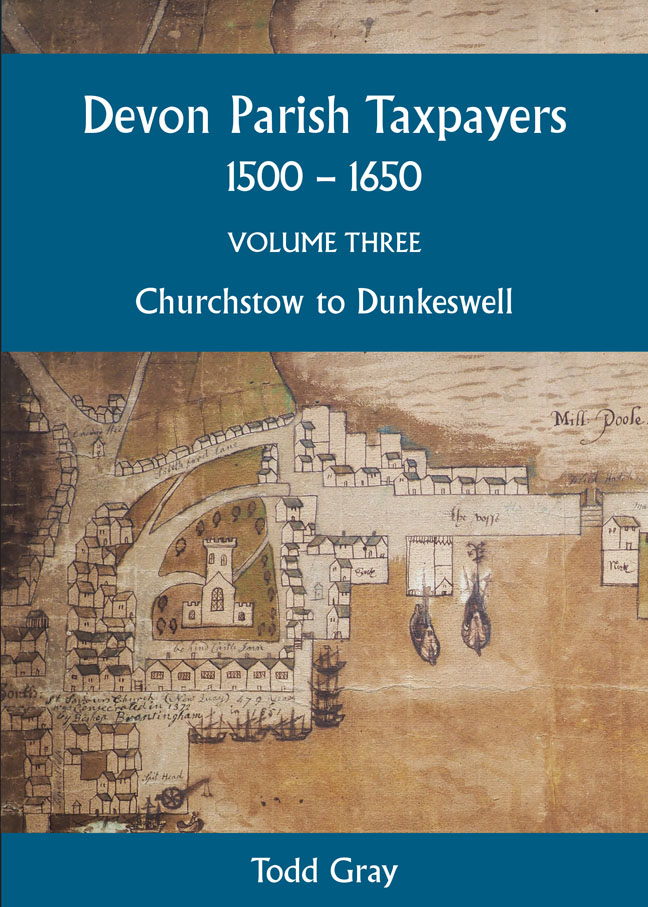Book contents
- Frontmatter
- Dedication
- Contents
- List of Illustrations
- Preface
- Introduction
- Editorial Conventions
- The Lists
- Appendix 1 Letter regarding financing church repairs at Colyton, 1 June 1606
- Appendix 2 Letter from to the churchwardens and overseers of the poor of St Saviour, Dartmouth, 6 March 1610
- Appendix 3 Dartmouth electors, 1626
- Appendix 4 Account of the head wardens of Dean Prior, 1580
- Index
- Devon and Cornwall Record Society
Crediton, some including Sandford, Church Rate, 1549; Easter Books, 1574, 1582 & 1594; Church Rate, 1619; Tithe Accounts, 1630, 1636 & 1644
Published online by Cambridge University Press: 17 February 2024
- Frontmatter
- Dedication
- Contents
- List of Illustrations
- Preface
- Introduction
- Editorial Conventions
- The Lists
- Appendix 1 Letter regarding financing church repairs at Colyton, 1 June 1606
- Appendix 2 Letter from to the churchwardens and overseers of the poor of St Saviour, Dartmouth, 6 March 1610
- Appendix 3 Dartmouth electors, 1626
- Appendix 4 Account of the head wardens of Dean Prior, 1580
- Index
- Devon and Cornwall Record Society
Summary
CREDITON
Detailed Elizabethan and early Stuart taxation records survive for this market town located eight miles north-west of Exeter. Crediton's history relating to financial administration has been examined more fully in pages xvii to xxxix.
In 1549 the scribe used Kirton, the alternative name for Crediton, as had John Leland seven years earlier when he noted ‘there is a pretty [prosperous] market in Kirton. The town useth clothing and most thereby liveth’. A century later Tristram Risdon wrote it was ‘the principal town upon this river [the Creedy]; an ancient borough, seated in the heart of the shire, partaking of the best, both for air and soil, of a red mould, and such as for the most part is accounted fertile land. Famous was this place in the time of the Saxons for an episcopal see here erected, in which sundry bishops successivley sat, until the reign of Edward, that holy king and confessor’. In 1644 a Royalist commented that Crediton was called ‘in the common manner’ Kirton and that it was ‘a great lowsy town, a corporate town governed by a bailiff’.
Sandford was a chapelry of Crediton and its parishioners were included in the latter's tax lists. In some they were separated from those who lived in the parish of Crediton. In 1559 it was claimed that ‘there containeth in Kirton parish the number of 16 hundred people & besides six hundred in Sandford which is annexed unto Crediton and a daughter to the same even now at this day’. The records include a long series of warden accounts, which specify the income streams available to the corporation, which cover the years 1550 through to the 1770s. The scribe from 1551 to 1583 was Hugh Deane, clerk to the twelve governors.
49. CREDITON, Church Rate, 1549
DHC, 1660A/0/A/4
Note: This rate was written, on sheets of paper which were folded to make twelve pages 4 inches in width and 12 inches in length, during the year of the Prayer Book Rebellion in which Crediton played a key part. The rebels gathered in the town and a skirmish took place in which several barns were set on fire in the king's cause. It was later claimed that ‘The Barns of Crediton’ became a rallying cry ‘flaming the beacon of insurrection’.
- Type
- Chapter
- Information
- Devon Parish Taxpayers, 1500-1650 , pp. 92 - 157Publisher: Boydell & BrewerPrint publication year: 2023



